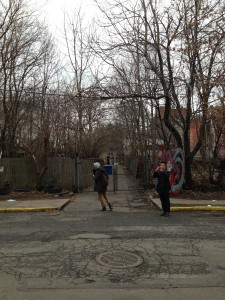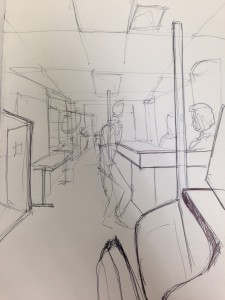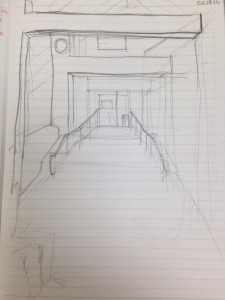Author Archives: Kyra Cuevas
Reflections #6: Hypothesizing Vinegar Hill during the 1920’s-1960’s
In the 1920’s- 1960’s Technology stimulated infrastructural growth, as well as the growth of the manufacturing industry. Examples of infrastructural growth would pertain to the addition of the BQE, and the extension of the Brooklyn and Manhattan Bridge Extension Conditions. Growth of the manufacturing industry is also transparent through the use of the Navy Yard and through the structural methodology of steel and glass in architecture. Forms of technology that facilitated documentation during this growth period ranged from visual sources to verbal sources. Visual sources consist of photographs, varying from either aerial views or views at eye level as well as maps drawn from government agencies such as NYCHA or the Mayor’s Committee. Verbal sources consist of radio broadcasts and newspapers. Today, Vinegar Hill participates in the Brooklyn Tech Triangle, which is prevalent through it’s preservation of technologies and reinvention of construction and manufacturing methodologies i.e, CNC milling or 3D printing ship parts to design experimentation for facades etc.
Vinegar Hill has several entities contributing to it’s development, such as NYCHA, the Mayor’s Committee, Mayor LaGuardia and Robert Moses. Other agencies which participated in the growth of urbanism in Vinegar Hill would be the Department of Transportation, Department of Parks and the Brooklyn Navy Yard. Each of these entitites are drivers whom revitalized vinegar hill, by created new infrastructures, parks, housing complexes etc. Today, transportation has been made much more accessible through the addition of buses and trains, as well as projected bike paths. The power authority has also continued it’s presence through the utilization of the Con Edison properties.
Information that may have not been captured around this time period probably related to agricultural exports, imports or inventory as well as energy simulation through gas or electricity. We hypothesized that water and food quality were also not surveyed around this time.
Brooklyn Public Library Site Report
Vinegar Hill Report 2
Reflections #5: Archiving Robert Moses
The NYPL Robert Moses archives contain a wide breadth of information. The archive encompasses his personality and his being, whereby it is cohesive and stark as a whole, but in pieces are sporadic and heavily concentrated. That being said, it includes a variety of documents: photographs, printed matter, speeches, correspondence papers that record his reign in numerous office, and his invention of several major public transportation and parks projects.
These papers are organized chronologically, although sometimes events and projects in his life overlapped, therefore some timelines bled over each other. Each paper is linked to a page which further summarizes the contents of the document. Some papers are highly dense, thus they are further segmented (ex. the 1st Series: Personal and Library Correspondence) or highly organized and indexed. All of these documents however, facilitate the need to contact the NYPL ARCHIVES & MANUSCRIPTS division to plan for a visit to study these documents.
Reflections #4: RECAPing Auld Irishtown
I was very pleased to encounter Loingsigh’s writing. It was intriguing to follow up with this article having read the Smithsonian’s “Whiskey Wars” prior to this. Loingsigh’s article has put the Whiskey Wars in context of a greater history, while tracing the trajectory of Irish history within Vinegar Hill. His mode of research was based off of several strategies, one of which was the experiences of his grandmother, who was a primary source at hand. The layers he discovered are native to his homeland, which is not a common experience in the melting pot of New York City.
In regards to the RECAP evaluation, This article was relevant for our previous readings, and for our site visits as well. Loingsigh’s expertise is apparent in his writing style, as he is planning to write 3 books based on this historic matter. Loingsigh gives the reader a large window, which tells us that his idea of tracing history was inspired by the early stories of his grandparents (early 20th century) to recent research he as uncovered in the past decade (the articles on the White Hand Gang, and Martin Scorsese’s Gangs of New York). His grandparents serve as primary sources, while his research conducted within Municipal Archives on Chambers Street and New York Times articles which also proves to be primary and secondary sources. The purpose of this article was to inform readers both about the author’s upcoming works, and to offer a new range of information which was undocumented on Irishtown’s history. Loingsigh stresses the loss of information on Irishtown, how it was not charted as a territory, but exists through the experience of others.
Vinegar Hill Site Report 1
Kyra Cuevas – Vinegar Hill Site Report 1
In addition to submitting the report, I’d like to add that I’m having a bit of a technical issue regarding one of the photos within the file. For some reason it won’t crop at the right place, so I will attach it here.
This is the picture I will submit in lieu of the photo that is improperly cropped.
Sketches: Atrium and Computer Lab
Reflections #3: Rabbit Holes
The idea of a virtual world, or virtual sphere is clearly explored through the wikigalaxy. While theoretical, wikigalaxy also uses information a map out different articles to each other. By nature, and as described by this article, I sometimes find myself scrambling through various articles of different subjects through links and various sources. It’s fun to see this phenomenon in 3 dimensions, whereas a web page feels much more like a 2 dimensional interface.
I wonder what would happen if we suddenly decide to change search engines to look like this. Would we begin to lose focus, and thus follow rabbit holes? Or will we be driven by how links look like, rather than the use of keywords?
Reflection #2: The Whiskey Wars That Left Brooklyn in Ruins
This article helped clarify the relationship between taxation and criminalization. Reminscent of the Boston Tea Party, the idea of tax for businesses such as distilleries induced a criminal like lifestyle. Despite it’s legality, the sudden tax increase of alcohol was quite absurd, from $2 – $30. That amount (equivalent in today’s terms) was enough to send Irishtown, or what was Vinegar Hill “over the hills”, whereby the creation of an underground ring for importing and exporting liquor feasible. Irishtown was conveniently located next to a port, which was perfect for smuggling. Street gangs, sailors and smugglers were born, as corruption rings in the police force were also apparent.
The presence of corruption did not limit itself to Vinegar Hill, but instead showed itself to be a prime example here. Allegations were found as far the White House, which makes the reader understand the breadth and urgency of taxation. I found this article not only to be entertaining and informative, but as a great piece to commemorate Vinegar Hill’s rich history. However, I’m a little disappointed in how the author summarized the deterioration of the Irishtown ring, as I wish Dalzell was more descriptive about it. Also, I wish Dalzell included more forms of documentation within the article (i.e Whiskey labels, distillery images, maps of the raids etc.)






